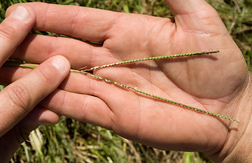This page has been archived and is being provided for reference purposes only. The page is no longer being updated, and therefore, links on the page may be invalid.
Read the magazine story to find out more. |
|
|
Faster Forage Option for Growers
By Sharon DurhamApril 1, 2008
A new bahiagrass may provide forage growers with a better shot at beating back weeds before they gain a stranglehold on forage pastures. Agricultural Research Service (ARS) scientists in Tifton, Ga., have developed a cultivar called "TifQuik" that would do just that.
Geneticist Bill Anderson and colleagues in the ARS Crop Genetics and Breeding Research Unit in Tifton developed TifQuik, a bahiagrass with great potential as a forage grass in the Southeast. ARS is the U.S. Department of Agriculture's (USDA) chief scientific research agency.
Released by the USDA and the University of Georgia (UGA), TifQuik provides faster germination and field establishment than Tifton 9, another USDA/UGA variety that's widely grown for forage.
Most bahiagrass cultivars currently available require two to three weeks to establish a full stand. During this time, weeds may infest the pasture, and moisture for forage seed germination may be restricted.
The sole criterion for selection of plants to develop TifQuik was fast germination. Former ARS agronomist Roger Gates and retired geneticist Wayne Hanna performed four selection cycles, beginning with Tifton 9. Plants were allowed to cross-pollinate, seed was hand-harvested, and that seed was then used to start the final selection cycle in a greenhouse.
In greenhouse studies, the germination rate of TifQuik averaged five times greater than that of Tifton 9 after six days, and three times greater after eight days. One week after planting, TifQuik emerged about 75 percent faster than Tifton 9 and Pensacola, another commonly used forage bahiagrass. Four weeks after planting, TifQuik plants were taller than those of both Tifton 9 and Pensacola.
TifQuik will be particularly valuable to growers wanting to include bahiagrass in a sod- based rotation system with row crops such as peanut and cotton in the Southeast. Bahiagrass has been shown to reduce nematode and disease problems in subsequent crops, and it should provide many forage growers with another tool to make their operations more efficient and perhaps more profitable.
Read more about this research in the April 2008 issue of Agricultural Research magazine.

